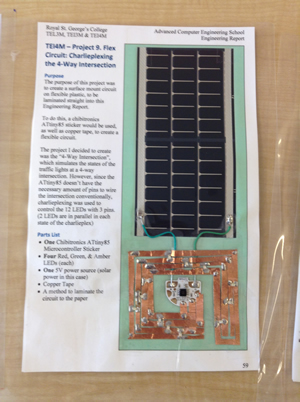
| 2017-2018 TEI4M Flex Circuit Page |

![]() Flex Circuit Page. Even though this description is a little long, please be sure to take it ALL in before deciding on a circuit you will be proud to reflect for years to come.
Flex Circuit Page. Even though this description is a little long, please be sure to take it ALL in before deciding on a circuit you will be proud to reflect for years to come.
YOU WILL PREPARE TWO WORKING VERSIONS OF YOUR CIRCUIT:
ONE FOR YOUR ER and ONE FOR OUR RSGC ARCHIVES!!
So, here's the basic concept. Download, consider, and complete the FlexPageProposal.docx when you're ready to commit.
For the third consecutive year, Sr. ACES are asked to embed within their Engineering Report a unique, live, solar-powered microcontroller-based circuit. In the future, when you show your ER the light of day, readers will marvel at what you accomplished in high school. A photo of Ryan Power's effort from 2016 follows the formatting of all the other pages in his ER except the cutaway is an intersection circuit that goes live when placed in sunlight due the to MPT3.6-150 solar panel laminated into the page. Ryan's report continues on the backside of the page. Check out the results of all the 2015-2016 ACES.
In maintaining the ACES' tradition of improving on already terrific intiatives, you are asked to design and outsource the production of a flex circuit as a base for SMT page. ACES from the previous two years have used copper tape for traces, ATtiny85 flexible breakout boards or thin Surfboards from Digikey. You, the 2017-2018 ACES, have the privilege of setting the bar even higher in that you will be the first to incorporate a flexible circuit into your Flex Page, laminating it together with a Powerfilm solar cell to power either an SMT ATtiny84, ATtiny85 or ATmega328P microcontroller. The programming language is up to you but since the complexity of the circuit is not the real priority, I know you'll consider putting your assembly language skills on display in your circuit and your pages. Supporting components should be designed for the 1206 Package as that's what the DES manitains in its inventory. Below is a closer look at a Flex Matrix Oliver L. undertook while in Grade 11. A stencil is highly recommended as it dramatically simplifies and shortens the hot-air soldering process and time.
| Oliver's Finished Flex Matrix | Oliver's Flex Circuit Stencil |
|---|---|
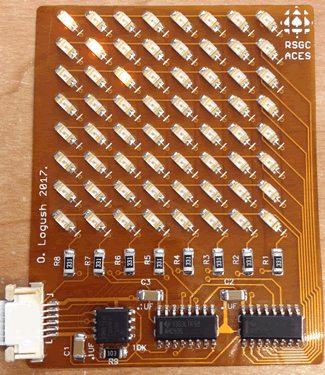 |
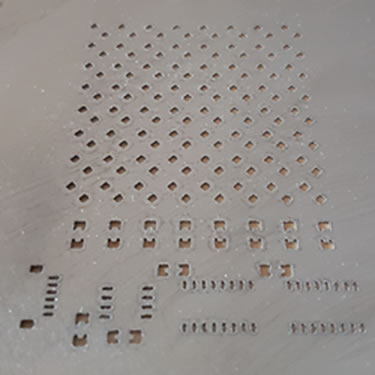 |
| Flex Circuits & Thin Film OLED | Dirty PCB Ordering |
 |
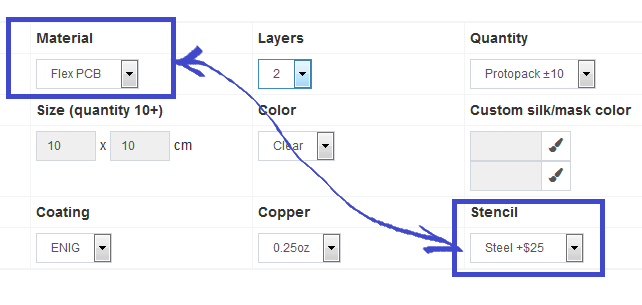 |
Hardware Provided
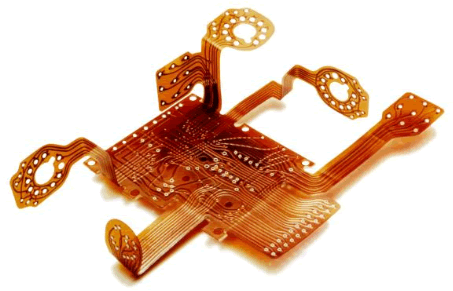 Within reason, the hardware parts will be supplied to you. For example, you will be provided with the solar flex cell, the SMD microcontroller, as well as simple 1206 passives such as resistors, capacitors, buttons and LEDs. Just be sure to answer my call for Digikey orders promptly.
Within reason, the hardware parts will be supplied to you. For example, you will be provided with the solar flex cell, the SMD microcontroller, as well as simple 1206 passives such as resistors, capacitors, buttons and LEDs. Just be sure to answer my call for Digikey orders promptly.
In return, you can be responsible for the cost or your flex panel. On this score, since your microcontroller must have an ISP capability, be sure to design in a 6-pin connection that will interface with the Chibitronics device pictured to the right.
Resources
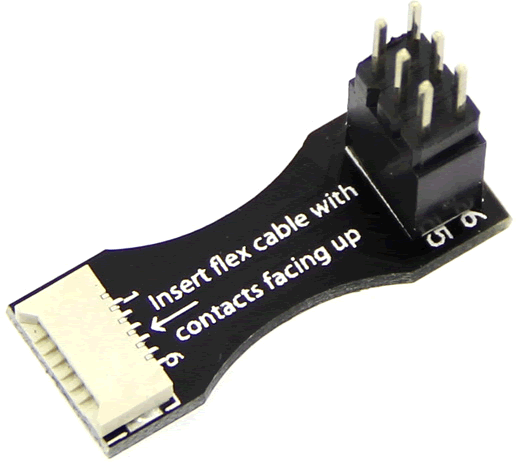 ACES:
Common
Flex Page
Parts
ACES:
Common
Flex Page
Parts
Minco: Flex Circuit Design Guide
ACES: 2016-2017 TEI4M Logs
PowerFilm: Flex Solar Cells
Adafruit: SMT (Medium) Test Socket for SOIC-8
Chibitronics:
ATtiny85 Sticker Tutorial (that ISP Adapter would be a good board to have in the DES!)
Quad Industries: Screen Printing
Sparkfun: IC Packages Explained
Videos
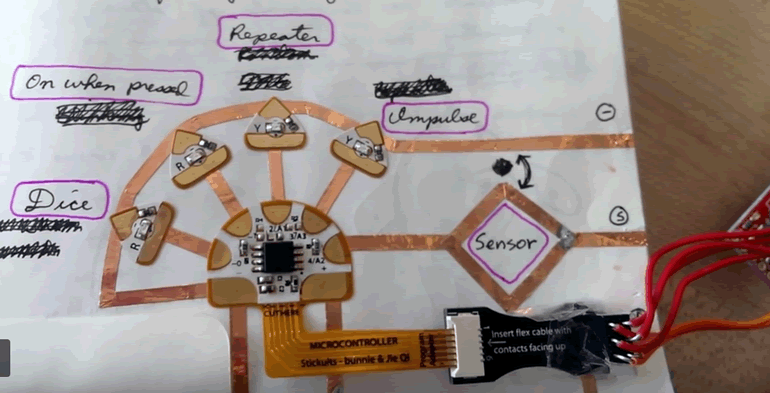
![]() The MPT3.6-150 Solar Module, (Specs)
The MPT3.6-150 Solar Module, (Specs)
![]() Pro SMT Hand Soldering: Part 1, Part 2
Pro SMT Hand Soldering: Part 1, Part 2
![]() Soldering Powerfilm
Soldering Powerfilm
![]() P. Bagga's (ACES' 17) SMT Soldering of his DC Power Breakout Board (a little too much solder paste but it still worked)
P. Bagga's (ACES' 17) SMT Soldering of his DC Power Breakout Board (a little too much solder paste but it still worked)
![]() J. Russett's (ACES '16) Flex Page Circuit: Induction
J. Russett's (ACES '16) Flex Page Circuit: Induction
![]() A. Elder's (ACES '17) Flex Page Circuit: Infrared Receiver
A. Elder's (ACES '17) Flex Page Circuit: Infrared Receiver
![]() O. Logush's (ACES '18) Flex Page Circuit: 'Charlie'flexed Matrix
O. Logush's (ACES '18) Flex Page Circuit: 'Charlie'flexed Matrix
| ATtiny85 SOIC-8 | PowerFilm Solar Cell / Surfboard 9081 |
|---|---|
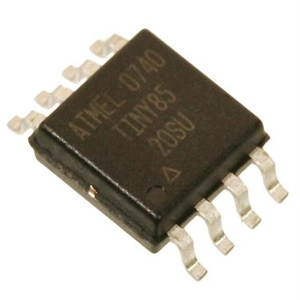 |
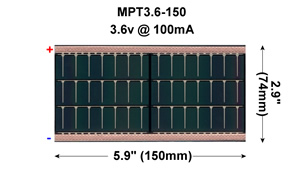 |
Task.
| 1796-ADA SMT Test Socket - Medium SOIC-8 (ATtiny85) | 1283-ADA SMT Test Socket - Narrow Breakout SOIC-16 (ATtiny84) |
|---|---|
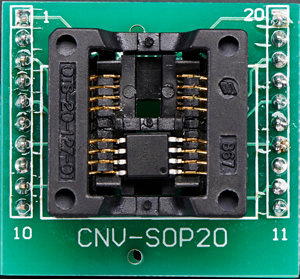 |
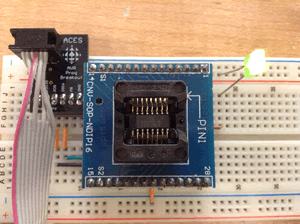 |
![]() DC Power Jack. Your experience with electric circuits has been largely limited to components that use through-hole technology (THT). To round out your proficiency with all components, your next few projects will require the use of devices that use surface-mount technology (SMT). As the graphic reveals, the smallest size that is reasonable for hand-soldering techniques is the 1206 family, so this is what we carry in the DES inventory.
DC Power Jack. Your experience with electric circuits has been largely limited to components that use through-hole technology (THT). To round out your proficiency with all components, your next few projects will require the use of devices that use surface-mount technology (SMT). As the graphic reveals, the smallest size that is reasonable for hand-soldering techniques is the 1206 family, so this is what we carry in the DES inventory.
DC Jack PCB |
1206 LED Package |
|---|---|
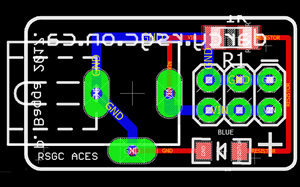 |
Task.